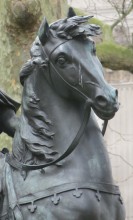
Here is a page of pictures of equestrian or horse statues, collected on this website of mostly art historical sculptural interest, for people interested in drawing and sketching, and from an art historical point of view, for comparison of style. The usefulness of drawing from horse sculptures is that the sculptor has already reduced extraneous detail, emphasised the masses and underlying structure of bone and muscle, and made some interpretation that embodies the concept of horsiness, and the bronze, typically painted black, is effectively monochrome.
Here are a variety of poses - standing, walking, trotting and rearing up, and as the styles used by sculptors changed over time, I have chosen three periods, starting with Le Sueur's famous statue of Charles I at Trafalgar Square, which dates from before the Fire of London, then three equestrian statues from the first half of the 19th Century, and then three early 20th Century examples, put up after World War 1. All these horse statues are in London. I have taken standard views of each horse, front, left, back and right, and on the second line for each horse are standard portraits of the horse's head from front, left and right. The lighting changes between pictures, as some had to be taken on different occasions and times of day to avoid a dark silhouette against a too bright sky.
As ever, click on the pictures to enlarge and scrutinise closely; the pictures are somewhat larger than the norm for this site, again, to aid drawing.
If you are interested in just drawing, and not particularly sculpture, I would still encourage you to glance at some of the pictures of other Victorian and Edwardian sculptures scattered elsewhere on these pages - many with artistic inclinations start from looking at illustrations and paintings, and come late to an appreciation of sculpture. You may like the animals pages accessible from this page, and the page on mermaids, and there is a page on sculptured hands for drawing.
Charles I, Trafalgar Square by Le Sueur, 1633..
Hubert le Sueur's horse of Charles I, in Trafalgar Square, shows a sculptural style of the 17th Century - a rather solid, rectangular body, massive neck, and formal pose, pacing deliberately forward. The horse is somewhat large for its rider. The tail is long, combed straight, with a tie of hair across the back, as seen in the rear picture. A comparison of the portrait pictures shows that by contrast, the mane has characterful twists and locks, and is swept over to the right hand side of the neck. The beast's expression is almost human, somewhat lagubrious. The body is largely smooth, excepting for wrinkles along the neck where it turns, and some emphasis on the veins of the legs.
William III, St James Square, John Bacon, Sr. and Jr., 1807.
Some 170 years on, and the equestrian statue of William III by John Bacon Sr., completed by his son John Bacon Jr., has a similar pose to the horse of Charles I, but is more active. The wind-blown mane blows forward on both sides of the proud neck, and strands from the long tail surge forward. The surface is much modelled by the muscles underneath, including showing muscles against the bones of the legs, a very successful treatment; note especially the ligaments around the knee. William III is shown as a hero in classical drapes, poised leaning slightly back on the saddle, with long hair blowing backwards rather than forwards, not actually that unreasonable given eddies of wind at differing heights above the ground.
George III, Cockspur Street, by M. C. Wyatt, 1836.
M. C. Wyatt's horse of George III, dating from 1836, is a sleek creature typical of the 19th Century. While the figure was much lampooned, principally for the pigtail, I am not aware that the horse attracted rebuke. A mobile creature, back legs bent, front hoof raised, this is our most naturalistic horse so far. As with Le Sueur's horse, the mane hangs mostly on one side, and the strands of hair of the tail are parallel, though the tail here is stretched out rather than hanging down.
Wellington, by Bank of England, by Chantrey, 1844.
Sir Francis Chantrey, the most prolific Victorian sculptor, died in 1841; this equestrian group was erected three years later. A most elegant horse by a sculptor of consistent quality.
For another Chantrey horse in London, see this page.
George Stuart White, Portland Place, by John Tweed, 1922.
A treatment simplified to the broad masses, with the detail of mane and tail lost. More on John Tweed on this page.
Cavalry Monument, Hyde Park Corner, Adrian Jones, 1924.
The Cavalry Monument shows a triumphant St George above the defeated dragon. The sculptor, Adrian Jones, had a lifelong devotion to horses, being a vet in the Royal Horse Artillery before he turned to sculpture. The horse has his head bowed and twisted, emphasising the muscles of the neck. See also this page.
Edward VII, Waterloo Place, by Bertram Mackennal, 1924.
A rather solidly built horse with much surface detail by the Australian-born sculptor Bertram Mackennal.
I'd be interested in any comments from anyone who does find this page useful for drawing practice; my email address is on the home page linked below.
Visits to this page from 22 Apr 2013: 9,232
More horse sculptures for drawing // sculptured hands for drawing // Sculpture of feet for drawing